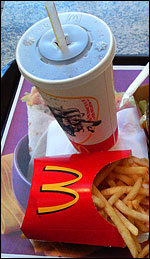
There has been a lot of great work in the last decade to wake kids up to alternatives to industrial food. Here and there, farm-to-school programs have been launched, soft drinks banished from cafeterias, books like Eric Schlosser’s Chew on This have emerged.
Yet clearly, much more work needs to be done. Seems that teens are still gulping down Coke and flocking to McDonald’s (when they’re not heading for Burger King, evidently seen by kids as the main alternative to McD’s).
I’m getting this from an article in BrandWeek on the latest marketing poll on teens. Evidently, Coca-Cola and McDonald’s remain the No. 1 consumer brands among the 11-18 set.
Other big, established brands did well, too: Nike, MTV, Seventeen, and Cover Girl. A marketing dude drew an important lesson from the news: marketing dudes rule. “These preferences definitely show that investing in brands still matters,” the fellow told BrandWeek (official journal of corporate marketers).
The food industry likes to paint food consumption as a matter of personal choice: free people in a free market choose what they want. And if what they want is artificially blackened beverages flavored with synthetic chemicals, well, that’s the way it goes.
But these mega food companies have hundreds of millions of dollars at their disposal to invest in branding, in capturing what marketers call mind share. They also have product ubiquity: their stuff is everywhere. With these two tools, they seek to crowd out other choices.
I doubt if any consumer, in the history of the world, ever woke up and said, I think I’ll have a glass of artificially blackened water, flavored with synthetic chemicals, and sweetened with genetically modified, ultra-processed corn. Yet literally billions of people across the globe make that choice everyday — not thinking about the GMOs or the chemicals, but rather the Brand. And they’re making it also because they can: Coke is everywhere.
I think that the sustainable food movement has to keep the power of Brand in mind as it proceeds. Personal choices don’t take place in a vacuum; they take place in a cultural context shaped by all manner of factors, including marketing campaigns and built infrastructure. Fast-food joints beckon from every street corner; farmers markets tend to concentrate in affluent areas.
A lot of people promoting sustainable food — most recently Michael Pollan and Alice Waters — fall into the “personal choice” trap. McDonald’s and Coke, with their vast marketing machines and decades-long ubiquity on the American cultural and physical landscape, win that game.
The BrandWeek article had an interesting bit about McDonald’s:
McDonald’s … benefits from its size, said Richard Adams, president of Franchise Equity Group, San Diego. “It’s about convenience.” Even though Burger King’s ads may resonate with teens, “if they aren’t available, there is a McDonald’s on every street corner,” said Adams. “That kind of dominance gives a lot of presence in the marketplace.” Analysts have also pointed to the Snack Wrap and other new items as being spot on with the wants of the younger consumer. BK was No. 2.
Part of the dominance of McDonald’s stems from its ubiquity. It operates an imposing infrastructure for delivering its style of food to all corners of the nation. And infrastructure, I think, is what the sustainable food movement needs to keep focusing on.

